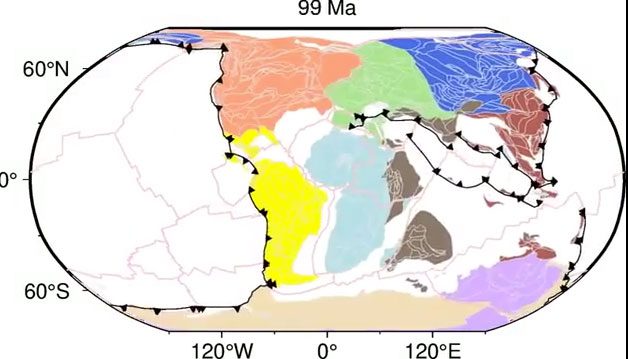The movement of tectonic plates on Earth has been recreated in a short video by a group of Chinese scientists.
Tectonic plates on Earth over the past 1.8 billion years. (Video: Tectonics and Earth Systems Group)
The research team, led by expert Xianzhi Cao from the Ocean University of China, utilized data from rocks on the Earth’s surface to reconstruct tectonic plate movements over the past 1.8 billion years, as reported by Science Alert on September 9. This new study was published in the journal Geoscience Frontiers. This is the first time geological records have been used in this way, allowing a glimpse into the planet’s past extending back 1.8 billion years in its 4.6 billion-year history.
The video begins with a familiar map of the modern world, then rewinds to the past. India rapidly moves southward, followed by parts of Southeast Asia, forming the supercontinent Gondwana in the Southern Hemisphere.
About 200 million years ago (with “million years” denoted as Ma in the video), when dinosaurs roamed the Earth, Gondwana was connected to North America, Europe, and Northern Asia, creating the supercontinent Pangaea. The video continues to rewind time, reaching back to when Pangaea formed from ancient tectonic plate collisions. Next, the supercontinent Rodinia appears, which formed from the breakup of an even older supercontinent, Nuna, approximately 1.35 billion years ago.

Video helps us look back at a past extending back 1.8 billion years in the 4.6 billion-year history of Earth.
Mapping tectonic plates in the past is the first step in creating a complete digital model of Earth throughout its history. This model will allow scientists to test hypotheses about the planet’s past, such as why the climate underwent the “Snowball Earth” period or why oxygen accumulated in the atmosphere.
Modeling Earth’s past is crucial for understanding how nutrients emerged to drive the process of evolution. The earliest evidence of complex nucleated cells—similar to all animal and plant cells—dates back to 1.65 billion years ago, around the time the supercontinent Nuna formed. The research team aims to investigate whether the mountains that developed during Nuna’s existence could provide factors that spurred the evolution of complex cells.
Many metals are formed in volcanic roots along tectonic plate boundaries. By recreating the locations of ancient tectonic plate boundaries over time, experts can gain a better understanding of the tectonic geography of the world and assist mineral explorers in locating ancient, metal-rich rocks buried beneath younger mountains.


















































